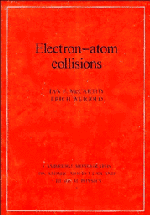Book contents
- Frontmatter
- Contents
- Preface
- 1 Introduction
- 2 Experimental techniques for cross-section measurements
- 3 Background quantum mechanics in the atomic context
- 4 One-electron problems
- 5 Theory of atomic bound states
- 6 Formal scattering theory
- 7 Calculation of scattering amplitudes
- 8 Spin-independent scattering observables
- 9 Spin-dependent scattering observables
- 10 Ionisation
- 11 Electron momentum spectroscopy
- References
- Index
10 - Ionisation
Published online by Cambridge University Press: 15 December 2009
- Frontmatter
- Contents
- Preface
- 1 Introduction
- 2 Experimental techniques for cross-section measurements
- 3 Background quantum mechanics in the atomic context
- 4 One-electron problems
- 5 Theory of atomic bound states
- 6 Formal scattering theory
- 7 Calculation of scattering amplitudes
- 8 Spin-independent scattering observables
- 9 Spin-dependent scattering observables
- 10 Ionisation
- 11 Electron momentum spectroscopy
- References
- Index
Summary
Electron–atom collisions that ionise the target provide a very interesting diversity of phenomena. The reason for this is that a three-body final state allows a wide range of kinematic regions to be investigated. Different kinematic regions depend sensitively on different aspects of the description of the collision.
Up to now there has been no calculation of differential cross sections by a method that is generally valid. We use a formulation due to Konovalov (1993). Understanding of ionisation has advanced by an iterative process involving experiments and calculations that emphasise different aspects of the reaction. Kinematic regions have been found that are completely understood in the sense that absolute differential cross sections in detailed agreement with experiment can be calculated. These form the basis of a structure probe, electron momentum spectroscopy, that is extremely sensitive to one-electron and electron-correlation properties of the target ground state and observed states of the residual ion. It forms a test of unprecedented scope and sensitivity for structure calculations that is described in chapter 11.
Other kinematic regions require a complete description of the collision, which may be facilitated by including the boundary condition for the three charged particles in the final state. This is nontrivial because there is no separation distance at which the Coulomb forces in the three-body system are strictly negligible. The pioneering experiments of Ehrhardt et al. (1969) are of this type.
An accurate description of ionisation channels is essential in a theory of scattering, even to low-lying discrete states at low incident energy. The first test of such a description is provided by the total ionisation cross section and asymmetry.
- Type
- Chapter
- Information
- Electron-Atom Collisions , pp. 261 - 288Publisher: Cambridge University PressPrint publication year: 1995

